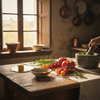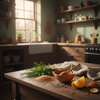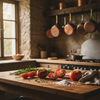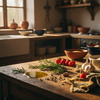Plastic Measuring Cups vs. Safe Alternatives 2025
Why Your Measuring Cup Choice Matters More Than You Think
Picture this: you're knee-deep in your grandmother's legendary chocolate chip cookie recipe, and suddenly you're second-guessing whether that slightly warped plastic measuring cup is giving you the right amount of flour. Sound familiar? Here's the thing—precision in cooking and baking isn't just about following directions; it's about having tools that deliver consistent, reliable results every single time.
Key Takeaways
- Choosing the right measuring cup is crucial for achieving precise and consistent cooking results.
- Warped or unreliable plastic measuring cups can lead to inaccurate ingredient measurements.
- Precision in baking and cooking depends heavily on the quality of your measuring tools.
- Using dependable measuring cups ensures your recipes turn out as intended every time.
Table of Contents
- Why Your Measuring Cup Choice Matters More Than You Think
- Understanding Plastic Measuring Cups: More Than Meets the Eye
- Types of Measuring Cups: The Dry vs. Liquid Divide
- Materials Showdown: Plastic vs. the Competition
- The Plastic Advantage: Why These Cups Earn Their Keep
- The Reality Check: Where Plastic Falls Short
- Making the Smart Choice: Your Plastic Measuring Cup Strategy
Quick Answer
Plastic measuring cups are lightweight, affordable kitchen tools made from food-grade plastic materials. They're versatile for both dry and liquid ingredients, stackable for easy storage, and typically dishwasher-safe. However, they can warp with heat, absorb odors over time, and may lack the durability of glass or stainless steel alternatives.
Whether you're tackling a soufflé for the first time or perfecting your holiday roast, the measuring cups in your drawer play a starring role in your culinary success. And if you're like most home chefs, you've probably got a plastic measuring cups set tucked away—maybe even that trusty 1 cup plastic measuring cup that's seen more action than a short-order cook.
But here's what's worth knowing: not all measuring cups are created equal. The material you choose affects everything from accuracy to safety, and yes, even how your food tastes. Plastic measuring cups have earned their place in kitchens worldwide for good reasons—they're budget-friendly, lightweight, and won't shatter if you accidentally knock them off the counter. But they also come with trade-offs that might surprise you.
Pro Tip: The difference between a good measuring cup and a great one often comes down to material choice. While plastic works for many tasks, understanding when to reach for alternatives can elevate your cooking game significantly.
In this comprehensive guide, we're diving deep into the world of plastic measuring cups—from understanding exactly what makes them tick to comparing them against glass, stainless steel, and other alternatives. We'll explore when plastic measuring cups shine brightest, where they fall short, and most importantly, how to choose the right tools for your specific cooking style and needs.
Ready to become a measuring cup ninja? Let's break down everything you need to know to make informed decisions that'll have you cooking with confidence and precision.
Understanding Plastic Measuring Cups: More Than Meets the Eye

Let's start with the basics. Plastic measuring cups are kitchen tools crafted from food-grade plastic polymers, typically polypropylene (PP) or polyethylene (PE), designed to accurately portion both dry and liquid ingredients. Unlike their glass or metal counterparts, these lightweight workhorses have become kitchen staples for good reason—they're practically indestructible in everyday use and won't send you to the emergency room if dropped.
But here's where it gets interesting: not all plastic measuring cups are created equal. The type of plastic, manufacturing process, and design details can dramatically impact everything from measurement accuracy to how long they'll last in your kitchen arsenal.
Key Fact: Modern food-grade plastic measuring cups are typically made from BPA-free materials and can withstand temperatures up to 200°F, though this varies significantly by manufacturer and plastic type.
What sets plastic apart in the measuring cup world is its unique combination of transparency and durability. That clear 1 cup plastic measuring cup in your drawer lets you see exactly what you're measuring while being light enough for one-handed use—try doing that with a heavy glass measuring cup when you're juggling multiple recipe steps.
Types of Measuring Cups: The Dry vs. Liquid Divide
Here's something that trips up even experienced home chefs: there's actually a science to choosing between dry and liquid measuring cups, and plastic options excel in both categories for different reasons.
Dry Measuring Cups in Plastic
Dry measuring cups are designed with flat rims that allow you to level off ingredients like flour, sugar, or rice for precise measurements. In plastic form, these cups are particularly brilliant because they're lightweight enough to handle easily while scooping from large containers, and they won't dent if you accidentally bang them against the side of your flour canister.
Most plastic measuring cups sets include the standard sizes: 1/4 cup, 1/3 cup, 1/2 cup, and 1 cup, with many premium sets adding 1/8 cup and 2/3 cup for more versatility.
Liquid Measuring Cups in Plastic
Liquid measuring cups feature pour spouts and graduated measurement lines, and this is where plastic really shines. The transparency allows you to read measurements at eye level accurately, while the lightweight nature means less strain when pouring from larger volumes. Plus, if you've ever tried to pour hot oil from a heavy glass measuring cup, you'll appreciate the control that plastic provides.
Pro Tip: When measuring liquids in plastic cups, always place the cup on a flat surface and read at eye level. The meniscus (curved surface of the liquid) should align with your desired measurement line for accuracy.
Materials Showdown: Plastic vs. the Competition

Ready for some real talk about measuring cup materials? Each option brings distinct advantages to your kitchen, and understanding these differences can seriously upgrade your cooking precision.
| Material | Best For | Heat Resistance | Durability | Price Range |
|---|---|---|---|---|
| Plastic | Daily use, storage-conscious kitchens | Up to 200°F | Good (3-5 years) | $5-15 |
| Glass | Hot liquids, microwave use | Up to 500°F+ | Excellent (10+ years) | $15-35 |
| Stainless Steel | Dry ingredients, professional kitchens | Heat-proof | Excellent (lifetime) | $20-45 |
| Silicone | Flexible storage, heat resistance | Up to 450°F | Very good (5-8 years) | $12-25 |
What's fascinating about this comparison is how plastic measuring cups carve out their own niche. They're not trying to be the most heat-resistant or the most durable—instead, they excel at being the most practical for everyday cooking tasks while keeping your budget and storage space happy.
The Plastic Advantage: Why These Cups Earn Their Keep
Let's cut through the noise and talk about why plastic measuring cups have earned their spot in kitchens worldwide. It's not just about being budget-friendly—though that certainly doesn't hurt.
Affordability That Makes Sense
A quality plastic measuring cups set typically runs $8-15, compared to $25-40 for equivalent glass sets. But here's what's really smart about this price point: you can afford to have multiple sets. Keep one set for baking, another for savory cooking, and maybe a third for messy tasks like measuring paint or craft supplies.
Storage Solutions for Real Kitchens
Ever tried to nest glass measuring cups? It's like playing kitchen Tetris with expensive, breakable pieces. Plastic measuring cups stack beautifully, and many sets feature nesting designs that take up minimal drawer space. Some even come with collapsible options that flatten for ultra-compact storage.
Everyday Durability
Drop a glass measuring cup, and you're sweeping up shards. Drop a plastic one, and you pick it up and keep cooking. This resilience makes plastic measuring cups particularly valuable in busy households with kids or in outdoor cooking situations where breakage is a real concern.
Smart Kitchen Tip: Many professional bakers keep both glass and plastic measuring cup sets—glass for hot liquids and precise liquid measurements, plastic for dry ingredients and everyday convenience.
The Reality Check: Where Plastic Falls Short

No kitchen tool is perfect, and plastic measuring cups have their limitations. Understanding these helps you use them more effectively and know when to reach for alternatives.
Pros
- Lightweight and easy to handle
- Virtually unbreakable in normal use
- Transparent for easy reading
- Stackable and space-efficient
- Dishwasher-safe and easy to clean
- Budget-friendly for multiple sets
Cons
- Limited heat resistance (typically 200°F max)
- Can absorb odors and stains over time
- Measurement markings may fade with use
- Less precise than glass for liquid measurements
- Can become cloudy or scratched
- Not suitable for very hot liquids
The key is knowing these limitations upfront. Don't use your plastic 1 cup plastic measuring cup for measuring hot oil or melted butter—that's a job for glass or heat-resistant silicone. But for room temperature ingredients, dry goods, and cold liquids? Plastic measuring cups are often the smarter choice. For more on ingredient prep, check out this chicken autumn veggie stuffed acorn squash recipe that puts measuring accuracy to the test.
Making the Smart Choice: Your Plastic Measuring Cup Strategy
Here's the bottom line: the best measuring cups are the ones you'll actually use consistently. For most home cooks, this means having a strategic combination of materials rather than going all-in on one type.
Consider plastic measuring cups your reliable everyday workhorses—perfect for the 80% of measuring tasks that involve room temperature ingredients, dry goods, and standard liquid measurements. Pair them with a single glass liquid measuring cup for hot liquids and microwave use, and you've got a measuring system that covers all your bases without breaking the bank or your storage space.
The real win with plastic measuring cups sets is their accessibility. When measuring cups are easy to grab, easy to use, and easy to clean, you're more likely to measure accurately instead of eyeballing ingredients. And in cooking and baking, that accuracy often makes the difference between good results and great ones. For a deeper dive into the science of kitchen plastics and health, see this microplastic exposure through drinking cups and human health impacts resource.
Whether you're a weekend baker, a weeknight dinner warrior, or somewhere in between, plastic measuring cups offer a practical foundation for precise cooking that won't intimidate your budget or dominate your kitchen storage. Sometimes the best tool isn't the fanciest one—it's the one that gets the job done, day after day, without any drama.
Frequently Asked Questions
Are plastic measuring cups good?
Plastic measuring cups can be handy and lightweight, but they often fall short when it comes to durability and heat resistance. They may stain, warp, or retain odors over time, which can affect accuracy and longevity in the kitchen.
What is the best material for measuring cups?
The best measuring cups are made from heat-resistant materials like borosilicate glass or high-quality stainless steel. These materials ensure accurate measurements, withstand high temperatures, and won’t absorb odors or stains, making them reliable partners for every recipe.
What is the difference between a glass measuring cup and a plastic measuring cup?
Glass measuring cups are typically more durable, heat resistant, and less likely to stain or warp, making them ideal for hot liquids and precise baking tasks. Plastic cups, while lighter and less fragile, can absorb odors, discolor, and sometimes flex, which may impact measuring accuracy over time.
Can boiling water go in a plastic measuring cup?
Most standard plastic measuring cups are not designed to handle boiling water and can warp or release chemicals when exposed to high heat. For boiling liquids, it’s safer and smarter to use glass or heat-safe silicone measuring tools that can take the heat without compromising your recipe or health.
Are plastic cups better than glass?
Plastic cups offer convenience and break-resistance, making them great for casual use or when weight and shatter safety matter. However, glass cups outperform plastic in heat resistance, accuracy, and longevity—qualities that serious home chefs and recipe perfectionists will appreciate.
Does it matter what kind of measuring cup you use?
Absolutely. The right measuring cup can be the difference between a kitchen win and a frustrating flop. Using durable, accurate, and heat-safe materials ensures your measurements are spot-on, your tools last longer, and your cooking stays safe and delicious every time.




